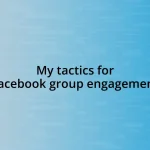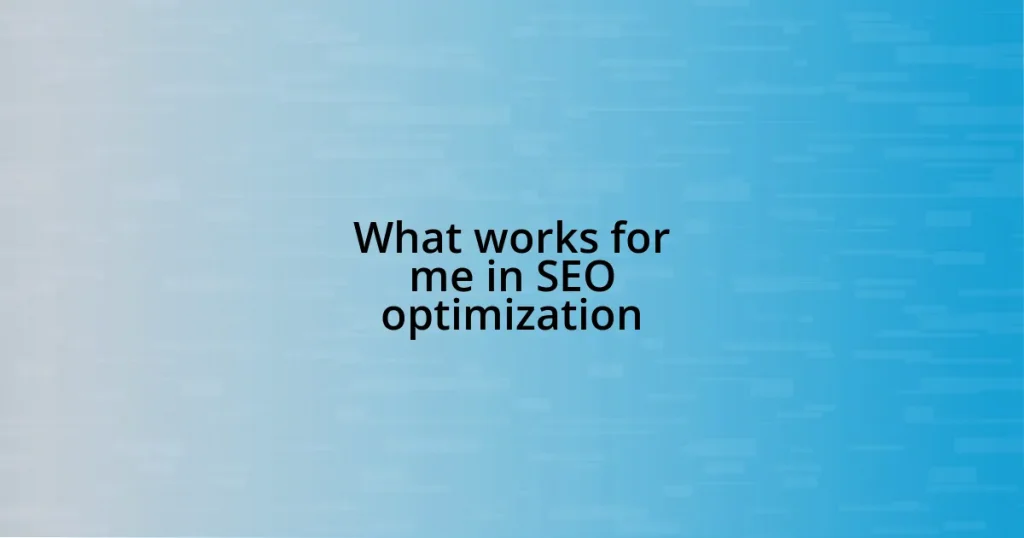Key takeaways:
- Community engagement thrives on active listening and recognizing diverse voices, fostering genuine connections.
- Identifying community needs requires various methods, such as surveys and focus groups, to ensure all perspectives are considered.
- Building trust and relationships through transparency and informal gatherings enhances collaboration and sustainability in community ties.
- Measuring engagement success involves evaluating both quantitative metrics and the quality of interactions to adapt strategies effectively.

Understanding Community Engagement
Community engagement is more than just a buzzword; it’s about forming genuine connections between individuals and their surroundings. I remember attending a local meeting where residents debated a new park design. The energy in the room was palpable, filled with passion and diverse opinions. It struck me how vital it is for everyone to have a voice at the table, fostering a sense of belonging.
When I reflect on my experiences, I notice that effective community engagement often involves active listening. Have you ever noticed how people light up when they feel heard? In one instance, I volunteered for a neighborhood cleanup, and witnessing how even the smallest effort could unite people toward a common goal was inspiring. It made me realize that engagement is about creating spaces for dialogue, where each person’s story adds richness to the community tapestry.
Moreover, community engagement isn’t just about speaking; it’s equally about understanding the silent voices. I once met an elderly neighbor who seldom left her house. By simply knocking on her door to say hello, I discovered an incredible wealth of stories and advice that enriched my own perspective. Isn’t it fascinating how engagement can unveil hidden gems within our community? It’s these connections that breathe life into the very essence of community.

Identifying Community Needs
Identifying community needs is the first crucial step toward fostering meaningful engagement. I have learned that sometimes, the loudest voices can drown out those who quietly suffer in silence. During a neighborhood forum I attended, I realized that many residents felt disconnected from local services. It was a humbling moment when I saw a young mother tearfully share how she struggled to access childcare resources. Her story illuminated the stark reality that not everyone’s needs are obvious.
To truly identify community needs, here are some practical methods I’ve found effective:
- Conduct Surveys: Simple questionnaires can gather valuable input from residents about their concerns and desires.
- Host Focus Groups: Bringing together diverse community members can spark discussions that reveal underlying issues.
- Utilize Social Media: Platforms like Facebook and Twitter can be powerful tools for informal feedback and engagement.
- Connect with Local Organizations: Nonprofits and advocacy groups often have insights into the community’s needs from their direct interactions.
- Listen Actively: Attend local events and listen to the stories shared; often, the needs are hidden in the experiences people share.
Engaging with these methods can create a clearer picture of what the community truly needs, leading to impactful actions.

Building Trust and Relationships
Building trust within a community is foundational for meaningful engagement. I vividly recall a neighborhood meeting where we discussed potential improvements to our local park. Initially, tensions ran high, with many suspicious of motives behind the proposed changes. However, once local leaders took time to share their own motivations and genuinely listen to residents’ concerns, the atmosphere shifted. Something magical happened; the walls came down, revealing the common goal of creating a vibrant space for everyone. Trust doesn’t build overnight; it’s a gradual process, often initiated through transparency and openness.
Furthermore, relationships flourish when individuals feel valued and respected. I remember hosting a small lunch gathering for a diverse group of neighbors. By creating a relaxed environment, stories flowed freely, and laughter echoed throughout the room. The shared meal became a backdrop for connection, allowing everyone to see each other as multifaceted individuals rather than just titles or roles within the community. This approach not only built trust but also sparked collaborations for future events. People need to see each other as partners in progress to cultivate sustainable community ties.
In essence, nurturing trust and relationships is about creating opportunities for interaction in everyday scenarios. I’ve found that community walks can be a simple yet effective way to engage with others. During one such walk, I met a newcomer who expressed deep appreciation for just being invited along. By engaging in casual conversation, we uncovered shared interests, paving the way for a friendship that’s enriched my experience in the area. So, how do we foster such moments? It starts with being intentional about creating spaces where people feel comfortable to connect.
| Trust Building Strategies | Example |
|---|---|
| Transparency in Communication | Sharing meeting agendas and outcomes openly. |
| Creating Informal Gatherings | Hosting potlucks or community walks to encourage interaction. |
| Listening Actively | Truly hearing concerns during discussions, showing that all voices matter. |
| Celebrating Community Stories | Highlighting local heroes and shared successes in newsletters. |

Creating Inclusive Programs
Creating inclusive programs requires a conscious effort to consider the diverse needs and experiences of all community members. I remember organizing a cultural festival where we aimed to represent various backgrounds. One unforgettable moment was when an elderly man approached me and shared how he had never seen his traditions celebrated in our community before. That conversation ignited my understanding of what true inclusivity looks like. It’s not just about inviting everyone but ensuring that their contributions and voices are genuinely valued.
Inclusive programs thrive when we pay attention to accessibility. A few years ago, I was involved in a community workshop designed for skill-sharing. Initially, we hadn’t considered physical access for individuals with mobility challenges. After hearing feedback, we adapted our space, ensuring everyone could participate comfortably. This experience taught me that true inclusivity must incorporate physical, linguistic, and cultural accessibility. Isn’t it empowering to create environments where everyone can join in and share their unique perspectives?
Moreover, fostering collaboration can deepen community ties. During a recent brainstorming session for a neighborhood clean-up, I noticed some participants were hesitant to share their ideas. By creating small breakout groups for discussion, I found that people felt more comfortable voicing their thoughts. The energy shifted dramatically, and suddenly, we had a wealth of creative solutions to work with. This made me realize that inclusivity is about actively encouraging participation and recognizing that every idea, big or small, is a step toward enriching our community. What if we all took a moment to reflect on the voices that remain unheard? Engaging with everyone not only enhances our programs but also cultivates a genuine sense of belonging.

Utilizing Social Media Effectively
Utilizing social media effectively can transform community engagement, allowing collective voices to echo far and wide. I recall a time when my local group created a simple Facebook page to gather community input on upcoming events. What surprised me was the sheer volume of responses we received—each comment reflected diverse opinions, preferences, and experiences. The ability to connect with residents beyond traditional meetings opened my eyes to the power of online platforms. How often do we underestimate the potential of a single post to ignite a discussion?
Moreover, using visuals can significantly enhance our online outreach. For instance, during a recent neighborhood clean-up initiative, we posted before-and-after photos on Instagram. The transformation was striking, and it generated excitement and motivation. Those shared images became more than just pictures; they turned into a rallying cry for community members to take part. By showcasing achievements visually, I found that it inspired deeper involvement as people yearned to contribute to future successes. Isn’t it fascinating how a single image can encapsulate an experience and foster connection?
Engaging through social media also warrants a thoughtful approach to interaction. I’ve learned that responding authentically to comments creates a sense of belonging and validation. For example, a resident once reached out to express concerns about a new park project. Instead of deflecting or providing generic responses, I took the time to engage in a meaningful discussion. A simple acknowledgment of their feelings led to a deeper conversation where we explored viable solutions together. This engagement taught me that social media isn’t just about broadcasting information; it’s about nurturing relationships and fostering dialogues that drive community initiatives forward. How could our engagement shift if we viewed every comment as an opportunity to connect?

Measuring Engagement Success
To truly measure engagement success, it’s crucial to define clear metrics that align with your community goals. I remember implementing a simple feedback survey after an event I organized; the results were eye-opening. Not only did we gather data on attendance, but the comments also highlighted areas for improvement and aspects that resonated well. It made me wonder—what metrics might we overlook that could provide deeper insights into our engagement efforts?
Tracking participation rates alone can be misleading; it’s the quality of interactions that often reveals the real story. For instance, during a community forum I hosted, I focused not just on the number of attendees, but on the richness of their contributions. I was thrilled to see participants eagerly exchanging ideas and building off one another’s thoughts. It really struck me—engagement isn’t just about numbers; it’s about creating an environment where voices can flourish. How often do we reflect on the depth of participation over mere attendance?
Ultimately, regular reflection and adaptation play a vital role in measuring success. After a series of workshops, I took a step back to analyze our achievements and missteps. One unexpected insight was how different our community preferred to engage—some loved face-to-face discussions, while others thrived in online platforms. I realize now that keeping an open line of communication for ongoing feedback creates a dynamic approach to community engagement. Isn’t it empowering to realize that engagement can evolve alongside the community’s needs?

Sustaining Long-term Participation
Sustaining long-term participation in community engagement requires intentionality and a commitment to creating an inclusive atmosphere. I once organized a series of monthly meetups designed to build camaraderie among participants, but it wasn’t until I introduced themed discussions that I really saw a spike in attendance. People thrived on sharing their perspectives and felt valued when their interests were reflected in our conversations. Isn’t it interesting how a little customization can make everyone feel invested?
Another approach I found effective was to provide consistent opportunities for feedback. During our community projects, I developed a simple suggestion box, both in physical form and digitally. I remember how a resident suggested we explore a local art installation, sparking a vibrant debate that led to an actual partnership with a local artist. The positive energy that this initiative generated made me realize that nurturing an environment where everyone’s voice matters can keep the momentum alive for the entire community. How often do we overlook the potential ideas that can spring from our community’s own feedback?
Lastly, celebrating small wins is essential for keeping spirits high and encouraging continued participation. After completing a neighborhood garden project, we hosted a simple barbecue to thank everyone involved. It was amazing to see familiar faces mingling and sharing stories about their experiences. The sense of pride and accomplishment in the air was palpable, highlighting how celebrating together fosters a sense of belonging. Wouldn’t it be inspiring if each engagement event could leave participants eager for more?















